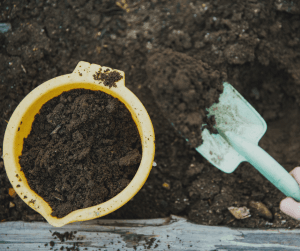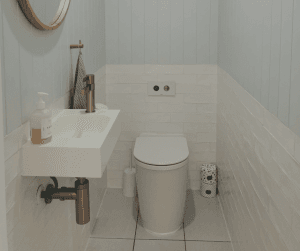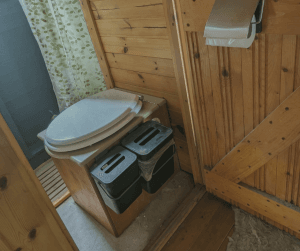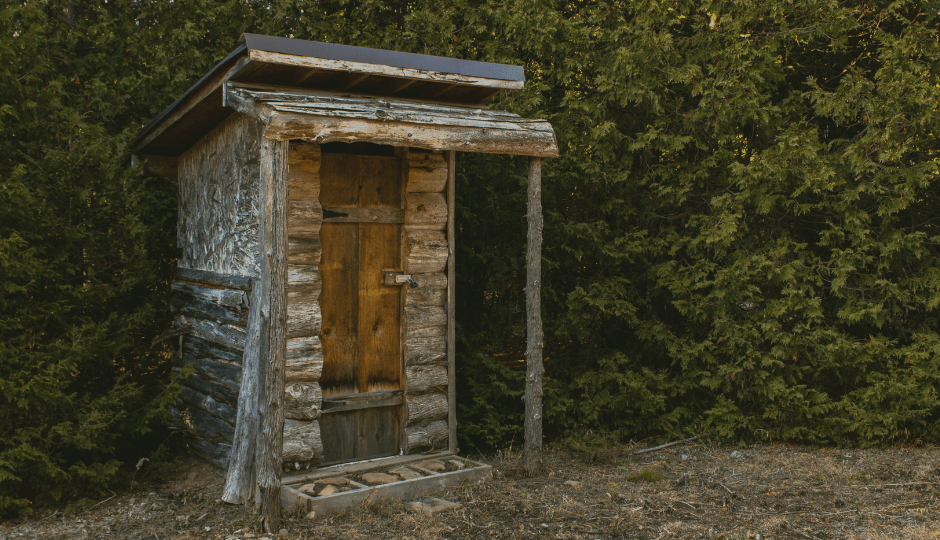Managing waste disposal off-grid presents some unique challenges that require careful consideration and planning. Unlike conventional homes connected to mains sewage systems, off-grid living demands self-reliant and efficient solutions for handling waste. Whether you live in a remote cabin, travel in a campervan, or reside on a boat, finding the right off-grid toilet is crucial to maintaining hygiene and comfort.
Sustainability is also a key concern. With increasing awareness of our environmental impact, it is more important than ever to choose waste disposal methods that minimise harm to the planet. This is especially true in off-grid settings, where resources are often limited, and the responsibility for waste management falls entirely on your shoulders. Fortunately, there are various types of off-grid toilets designed to meet the specific needs of different living environments. No matter your off-grid circumstances, there is a suitable toilet system to suit your needs.

Incinerator Toilets
How Incinerator Toilets Work
Incinerator toilets offer a unique approach to off-grid waste management by converting human waste into ash through incineration. Unlike composting or separating toilets, which manage waste through decomposition or separation, incinerator toilets completely eliminate waste by burning it at high temperatures. The process is simple: after each use, the toilet heats up, incinerating the waste into a small amount of sterile ash that can be safely disposed of. These toilets typically operate using electricity, gas, or other fuels, making them reliant on a consistent power source. Despite this requirement, the result is a sanitary, odour-free method of waste disposal that requires no water and minimal maintenance.
Eco-Friendliness
When considering the eco-friendliness of incinerator toilets, there are both advantages and disadvantages to take into account. On the positive side, these toilets reduce waste to a fraction of its original volume, resulting in no solid waste that needs to be stored or further processed. This complete elimination of waste is particularly beneficial in environments where waste disposal is challenging. Additionally, the absence of water usage is a significant environmental benefit, especially in areas where water conservation is crucial.
However, the fuel consumption required to operate an incinerator toilet raises some environmental concerns. Whether powered by electricity, propane, or another fuel, the energy used to incinerate waste contributes to the overall carbon footprint. Additionally, emissions from the incineration process, although minimal, are another factor to consider. Therefore, while incinerator toilets offer a highly effective waste management solution, they may not be the most eco-friendly option for all off-grid settings.
Best Use
Incinerator toilets are well-suited to off-grid homes with reliable power supplies, such as a robust solar panel system or generator. They are an excellent choice for locations where waste disposal is difficult, such as remote cabins or mountainous areas, where traditional waste management methods are impractical. These toilets offer a clean and convenient solution for off-grid living, particularly when hygiene and odour-control are priorities.
Composting Toilets
How Composting Toilets Work
Composting toilets offer an eco-friendly and efficient way to manage waste in an off-grid home. They break down human waste into compost through aerobic decomposition. Unlike conventional toilets that rely on water to flush waste away, composting toilets use natural processes to convert waste into valuable compost. This process typically involves separating liquids from solids, with the solids being broken down by microorganisms in a well-ventilated environment. Over time, this waste turns into a nutrient-rich compost that can be safely used to fertilise non-edible plants.
Central Composting Systems
These composting toilet systems are generally designed for permanent or semi-permanent locations. They involve a separate composting chamber, typically located beneath or outside the dwelling. The waste is transported from the toilet to the central chamber, where it decomposes over a longer period of time. This system is better suited to off-grid homes with more space, offering larger capacity and less frequent maintenance.
Eco-Friendliness
Composting toilets are among the most eco-friendly waste management options available. By using aerobic decomposition, they avoid the need for water and chemicals, which are typical in other waste disposal methods. The result is a system that not only reduces your ecological footprint but also returns nutrients to the earth. You can also create biogas with some composting toilets, which you can use to cook with or heat your home!
However, it’s important to manage the composting process correctly to ensure safety and environmental responsibility. Regular maintenance and proper handling of the compost are crucial to avoid any contamination and to maximise the benefits of this sustainable waste management method.
Best Use
Composting toilets are particularly well-suited to off-grid properties, tiny homes, and remote cabins. Their waterless operation makes them ideal in areas where water conservation is essential or plumbing infrastructure is limited or non-existent. The compost produced can be used to enhance soil quality, contributing to a self-sufficient lifestyle.

Separating (Urine-Diverting) Toilets
How Separating Toilets Work
Separating, or urine-diverting, toilets are designed to efficiently manage waste by dividing liquid and solid waste at the source. This separation simplifies the disposal process and reduces the potential for unpleasant odours, as liquids and solids are managed separately. The toilet is typically designed with two chambers: one for urine, which is directed to a separate container or drainage system, and another for solid waste, which can be collected and processed accordingly. They are easy to install and maintain, often requiring nothing more than a vent pipe and occasionally a small power source for a fan to aid in aeration. This system makes waste management more straightforward and reduces the need for water and chemicals.
Difference Between Separating and Composting Toilets
While both separating and composting toilets aim to handle waste in an environmentally conscious way, they operate differently. Separating toilets focus primarily on dividing liquids and solids, making it easier to manage waste, especially off-grid. However, separating toilets do not always involve composting the solid waste due to the time frame and storage capacity involved. Instead, the solids may be stored for later disposal or used with other waste management systems. In contrast, composting toilets are specifically designed to break down solid waste into compost through aerobic decomposition, often with the help of microorganisms. This fundamental difference means that while both systems are effective, they cater to different needs and scenarios.
Eco-Friendliness
Sustainable separating toilets don’t use water and prevent the mixing of liquids and solids, which creates complex waste management issues. By diverting urine, which can be used as a natural fertiliser, and keeping solid waste separate, these off-grid toilet set-up offers a more sustainable way to handle waste. The reduced odour also means less reliance on chemicals or other odour-mitigating products, further enhancing the eco-friendliness of this option.
Best Use
Separating toilets are popular in off-grid vehicles and boats, where space is limited and waste management needs to be efficient. These toilets are also a good choice for temporary off-grid setups, such as pop-up camping spots, where traditional waste disposal systems might not be available. The separation of liquids and solids reduces the risk of clogs and odours, making them more convenient for mobile use. They are ideal for situations where quick and easy waste disposal is necessary, without compromising on sustainability.
Macerator Toilets
How Macerator Toilets Work
Macerator toilets provide a practical waste management solution for off-grid living by converting waste into a slurry. This process allows the waste to be easily pumped out through narrow pipes, making it possible to install the toilet in locations far from a sewage outlet or where traditional plumbing might be challenging. When you flush a macerator toilet, the waste is directed into the rotating blades or grinders, reducing it to slurry. This slurry is then pumped out through narrow pipes, often upwards or long-distance, to a holding or black tank. The ability to pump waste over a considerable distance provides flexibility in the placement of the toilet, making it suitable for a variety of off-grid living situations.
Eco-Friendliness
The eco-friendliness of macerator toilets largely depends on how the waste is managed after it is pumped out. Unlike composting toilets, which convert waste into a usable resource, macerator toilets require a method for disposing of the black water, typically involving a black tank. This black water contains liquid and solid waste, which must be treated and disposed of responsibly to avoid environmental contamination. While macerator toilets do not require much water compared to traditional flush toilets, they do rely on power to operate the grinder and pump, which adds to their environmental footprint. Additionally, the need for black water disposal means that macerator toilets are not as inherently sustainable as other off-grid toilets, such as composting systems, which can recycle waste into useful by-products.
Best Use
Macerator toilets are suitable where traditional plumbing options are limited, such as boats or remote properties with black water tanks. Their ability to pump waste over distances and through narrow pipes makes them an excellent choice for installations where space is at a premium or where the toilet needs to be located far from the waste disposal system. For off-grid homes with reliable power and a well-maintained black water disposal system, macerator toilets are convenient and effective.
Off-Grid Flush Toilets
How Regular Toilets Work with a Septic Tank
In some off-grid homes, a regular flush toilet connected to a septic tank offers a familiar, straightforward waste management solution. The system works by using water to flush waste from the toilet into a septic tank, where solids settle at the bottom, and liquids rise to the top. The liquid waste, or effluent, then flows out of the tank into a soakaway or drain field, where it is gradually absorbed into the ground. Inside the septic tank, bacteria break down the solid waste, reducing its volume over time. However, the tank still needs to be emptied periodically to prevent overflow or failure.
While septic systems are effective, they can be vulnerable if not properly maintained. Blockages, excessive water use, or the introduction of non-biodegradable materials can lead to system failures. Additionally, soakaways can become clogged or saturated, particularly in areas with poor soil drainage, which can cause the system to back up or fail entirely. Therefore, it’s important to monitor water usage, avoid flushing inappropriate materials, and schedule regular maintenance to ensure the system functions properly.

Eco-Friendliness
The eco-friendliness of a flush toilet connected to a septic tank depends on several factors. Traditional flush toilets use a significant amount of water per flush, which can be a concern in off-grid settings where water conservation is critical. Moreover, the treatment and disposal of waste in a septic system must be carefully managed to avoid contamination of local water sources.
Proper disposal of septic tank waste is essential to minimise environmental impact. If a septic system is poorly maintained or the soakaway fails, untreated effluent can seep into the ground, potentially contaminating groundwater and surrounding ecosystems. Ensuring that the system is properly designed, regularly maintained, and used responsibly is crucial for minimising its environmental footprint.
Best Use
Flush toilets connected to septic tanks are commonly used in off-grid houses where waste can be collected and eventually pumped out for treatment. This system is only suitable for properties with sufficient space to accommodate a septic tank and soakaway, and where regular maintenance can be conducted. While you may find the simplicity and familiarity of a flush toilet convenient, it’s important to balance these benefits with considerations of water usage and the potential environmental impact of septic systems.
Cassette Toilets
How Cassette Toilets Work
Cassette toilets are a common solution for waste management in off-grid and temporary settings, such as vehicles, boats, and campsites. These portable toilets use chemicals to break down waste and control odours, making them a convenient option when traditional plumbing isn’t available. The basic operation involves a holding tank beneath the toilet seat that collects waste. After each use, a chemical solution is added to the tank to sanitise the waste, reduce odours, and initiate the breakdown process. This method allows the toilet to be used multiple times before the holding tank needs to be emptied and refilled with fresh chemicals.
The chemical solution typically contains deodorants, disinfectants, and breakdown agents, which work together to manage the waste and maintain hygiene. The waste is stored in the tank until it can be emptied at an appropriate disposal site. This makes cassette toilets particularly useful when access to a septic system or other waste disposal methods is limited.
Eco-Friendliness
While cassette toilets offer convenience and portability, their environmental impact can be a significant drawback. The chemicals used to break down waste and control odours are often not environmentally friendly, and their disposal can lead to pollution if not handled correctly. Many of these chemicals contain formaldehyde or other harsh substances that can be harmful if released into the environment.
To mitigate this impact, consider using eco-friendly alternatives to traditional chemicals. There are now several products on the market that use natural enzymes or biodegradable compounds to break down waste without the harmful side effects of conventional chemicals. These alternatives still control odours and sanitise effectively but with a reduced environmental footprint. Proper disposal of the waste, whether using conventional or eco-friendly chemicals, is crucial to ensure minimal impact on the environment.
Best Use
Cassette toilets are best suited for temporary off-grid situations where portability and ease of use are paramount. They are ideal for vehicles or boats, and are also popular at campsites or remote work sites where setting up long-term waste management solutions isn’t feasible. Cassette toilets are portable, easy to set up, and require minimal maintenance. These factors make them a go-to choice for short-term use in locations where waste disposal options are limited. However, it’s important to weigh these advantages against the potential environmental impact and consider more sustainable alternatives whenever possible.
Comparing Off-Grid Toilet Options
Factors to Consider
Choosing the right off-grid toilet involves considering several important factors to ensure the best fit for your environment and lifestyle. Space availability is often a concern, particularly in smaller off-grid settings like tiny homes or boats, where every inch counts. Some toilet systems, like self-contained composting or separating toilets, are compact and designed to fit in tight spaces. Others, such as central composting systems or flush toilets with septic tanks, require more room for installation and operation.
Power requirements are another key consideration. Some off-grid toilets, such as incinerator or macerator toilets, rely on electricity or other fuels to function. If you have a reliable power source, such as solar panels or a generator, these options may be viable. However, if power is limited, a non-electric composting or separating toilet may be a more suitable choice.
Maintenance needs vary widely between different types of off-grid toilets. For example, composting toilets require regular attention to ensure the composting process is effective, while chemical toilets need frequent emptying and refilling of chemicals. Incinerator toilets, while low-maintenance in terms of waste disposal, still require fuel and periodic ash removal. It’s crucial to choose a system that aligns with the level of maintenance you are prepared to manage.
Environmental impact is a significant factor, especially for those committed to sustainable living. Composting and separating toilets generally offer the lowest environmental footprint, turning waste into useful by-products or requiring minimal water and energy. Meanwhile, incinerator toilets consume fuel and produce emissions, and cassette toilets involve the use of potentially harmful substances. Balancing these environmental considerations with your practical needs is essential for making a responsible choice.
Cost will also be a factor when it comes to choosing the right off-grid toilet for your home. Websites such as WooWoo Waterless Toilets offer a range of toilets, including separating and incinerating toilets and you can easily compare prices or request help in making your decision.
Matching Toilets to Off-Grid Environments
To help you select the best toilet for your off-grid situation, here’s a quick reference guide:
- Tiny Homes: Consider a self-contained composting toilet or a separating toilet. These options are compact, require minimal space, and offer low environmental impact with easy maintenance.
- Remote Cabins: Central composting systems or incinerator toilets work well in remote settings. These toilets offer high capacity and effective waste management, though they require more space and, in the case of incinerator toilets, a reliable power source.
- Live-in vehicles: Separating toilets or cassette toilets are popular choices for vehicles due to their portability and ease of installation. If you have access to power, a macerator toilet can also be a convenient option.
- Boats: Separating or macerator toilets are often the best fit for boats. These systems can handle the limited space and specific waste management needs of marine environments. Cassette toilets are also commonly used for their portability and simple maintenance.

By considering your specific off-grid environment and weighing factors such as space, power, maintenance, and environmental impact, you can select the most suitable toilet system to meet your needs and maintain a sustainable, comfortable off-grid lifestyle.
The Importance of Eco-Friendly Waste Disposal
Our Duty to the Environment
Living off-grid brings us closer to nature, which makes it crucial to manage waste in a way that protects the environment. This connection to the natural world amplifies our ethical responsibility to minimise our impact on ecosystems. Managing waste responsibly is a key aspect of this responsibility, ensuring that our actions do not harm the land, water, or wildlife around us.
Whether using composting, incinerator, separating, or cassette toilets, the way we handle and dispose of waste has a direct impact on the environment. Improper disposal of waste, particularly untreated waste or harmful chemicals, can lead to pollution, contamination of water sources, and long-term damage to the environment. Therefore, it is our duty to manage waste in the most eco-friendly manner possible, considering both the immediate and long-term effects of our actions.
Sustainable Practices
Adopting sustainable waste disposal practices is not just about choosing the right off-grid toilet—it’s about how we handle and dispose of waste to minimise environmental impact. Depending on the type of off-grid toilet system you use, there are specific methods and considerations for sustainable waste management.
- Composting Toilets: The waste from composting toilets can be converted into safe, nutrient-rich compost if managed correctly. Once it has fully decomposed and is safe for use this compost can be used on-site for gardening or landscaping. Regularly monitor the composting process to ensure that it is effective and free from contamination.
- Separating Toilets: With separating toilets, urine and solid waste are collected separately. Urine can often be used as a natural fertiliser, provided it is properly diluted and applied to non-edible plants. Solid waste can be composted or processed through other approved methods, ensuring it is handled safely and sustainably.
- Incinerator Toilets: These toilets reduce waste to ash, which is generally safe to dispose of as it doesn’t contain chemicals. Ensure that the ash is disposed of at approved sites or used in a way that won’t harm the environment.
- Cassette Toilets: Cassette toilets require particular care due to the use of chemicals in the waste breakdown process. Where possible, opt for eco-friendly chemicals that are biodegradable and less harmful to the environment. Waste from cassette toilets should always be deposited at designated waste disposal sites that can handle chemical treatment, preventing pollution and protecting local ecosystems.
- Black Water (Macerator Toilets): Black water, from macerator and some flush toilets, must be treated carefully to avoid environmental contamination. It should be stored in a sealed holding tank and regularly emptied at designated pump-out stations or treatment facilities. In some cases, black water can be treated on-site but this requires careful management and compliance with local regulations.
- Septic Tank Waste: Waste from septic tanks, usually generated by flush toilets, needs to be managed to prevent overflow or contamination of groundwater. Regularly pumping out the septic tank is essential, with the waste being transported to a licensed treatment facility. Ensure that the septic system is designed and maintained correctly to avoid leaks, clogs, or failures. The soakaway should also be monitored for signs of saturation, potentially indicating a need for maintenance or repair.
By choosing the most sustainable waste disposal methods and adhering to proper practices, you can significantly reduce your environmental footprint. This approach not only benefits the immediate surroundings but also contributes to broader environmental preservation efforts. You can ensure that your off-grid lifestyle aligns with the principles of sustainability and respect for the natural world.
Conclusion
Choosing the right off-grid toilet is a key decision that impacts both your comfort and environmental responsibility. Throughout this guide, we’ve examined a variety of off-grid toilet options, each offering unique benefits depending on your specific needs. Composting and separating toilets are sustainable choices that minimise environmental impact, making them ideal for those who prioritise eco-friendliness. Incinerator and chemical toilets, while more convenient in certain contexts, require careful consideration of their power requirements and the potential environmental effects of their waste disposal methods.
Ultimately, the best toilet for your off-grid lifestyle will depend on a number of elements. Consider aspects such as space availability, maintenance capabilities, and your commitment to sustainability. By carefully evaluating these factors, you can select a toilet system that not only meets your practical needs but also aligns with the principles of self-sufficiency and respect for the natural environment. In doing so, you’ll contribute to a more sustainable, eco-friendly off-grid living experience that honours the connection between our choices and the world around us.

To find out more about off-grid living return to our Reading Room.


